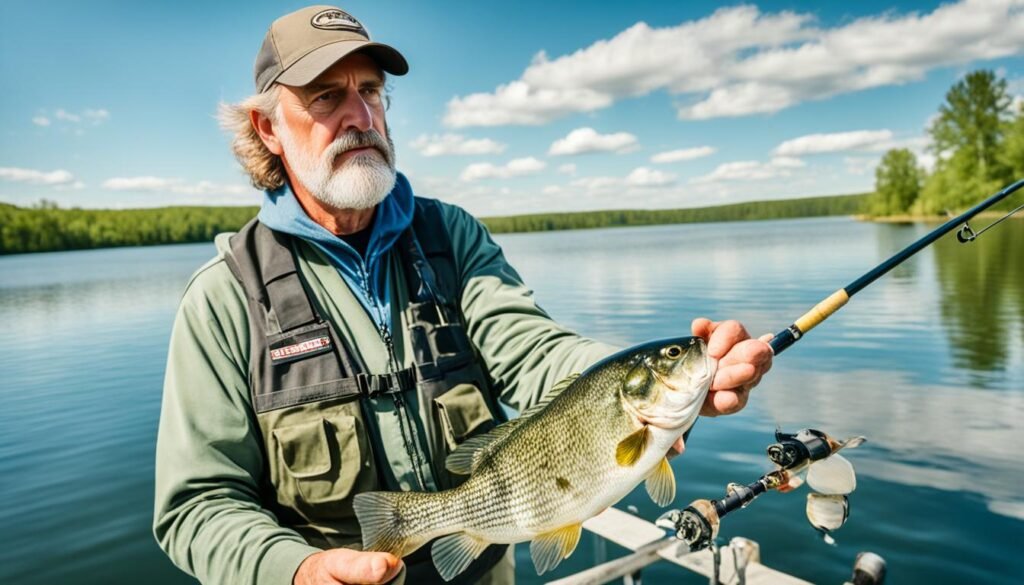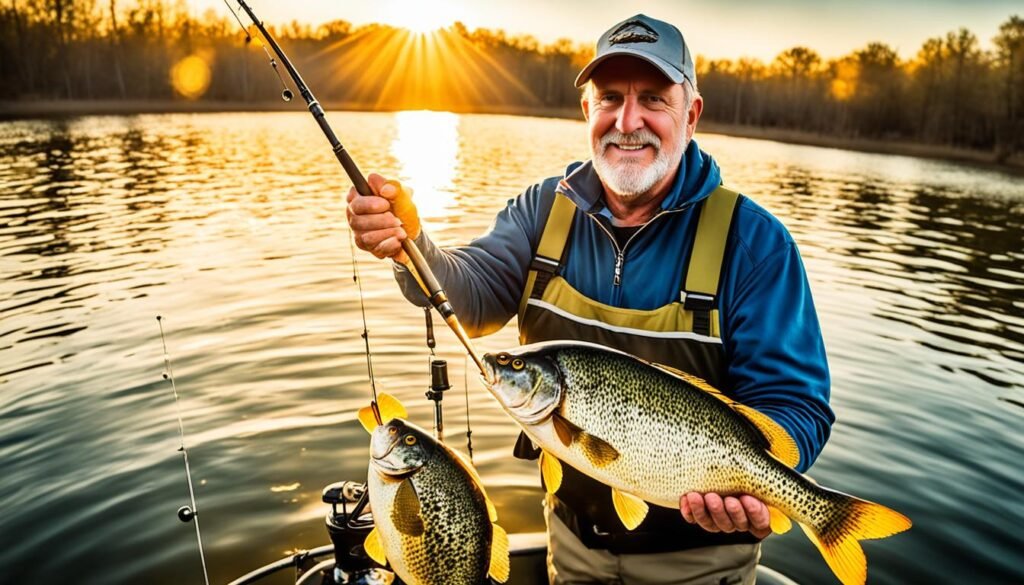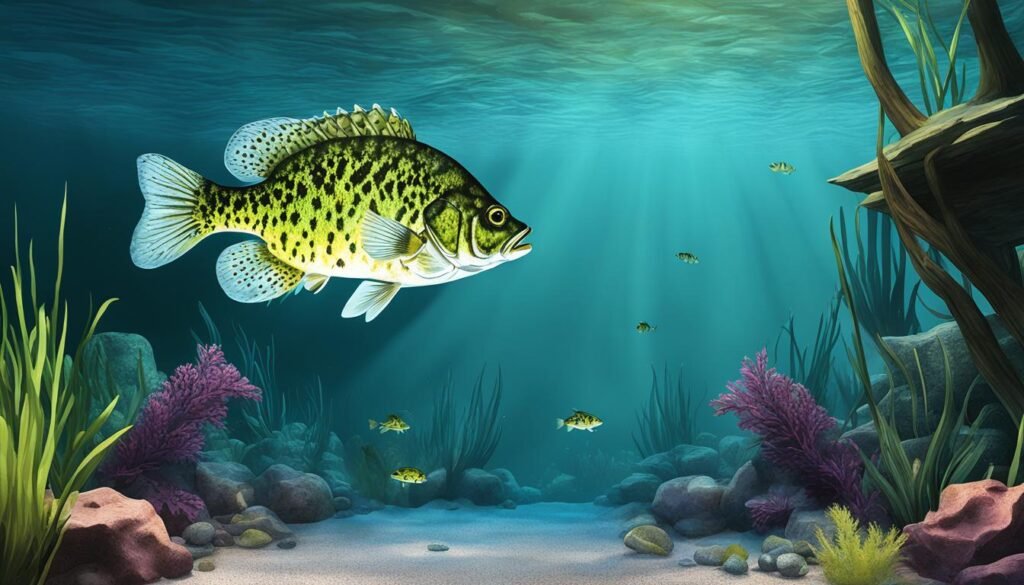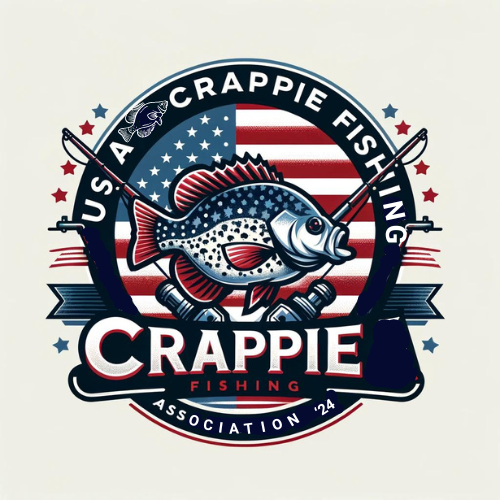Welcome to my guide on becoming a Crappie Whisperer, where you can unlock the secrets to mind-reading these elusive fish for insane catches. If you’re an angler looking to improve your success in targeting crappies, this article is for you. Through understanding their behavior and preferences, you’ll be able to outsmart these fish and reel in impressive catches.
Crappies are known for being elusive and have specific habits that can be challenging to decipher. However, by delving into their world and gaining insights into their feeding patterns, preferred habitats, and response to environmental factors, you can greatly increase your chances of success on the water.
Now, let’s dive into the details and explore the techniques and strategies that will make you a Crappie Whisperer and revolutionize your angling experiences.
Key Takeaways:
- Understanding crappie behavior is crucial for successful catches
- Decoding feeding patterns allows you to position yourself in the right spot
- Choosing the perfect bait and lures increases your chances of enticing crappies
- Mastering fishing techniques will help you adapt to different conditions
- Utilizing electronics and sonar devices improves your ability to locate crappies
The Importance of Understanding Crappie Behavior
When it comes to successful crappie fishing, understanding their behavior is key. By gaining insight into the feeding habits, preferred habitats, and response to environmental factors of crappies, anglers can greatly increase their chances of making impressive catches. Let’s explore some valuable fishing tips and freshwater angling strategies that will help you effectively target these elusive fish.
Feeding Habits and Preferences
Crappies exhibit specific feeding patterns that can vary depending on the season, time of day, and water conditions. By studying their behavior, you can anticipate their movements and adjust your fishing techniques accordingly. For instance, crappies are known to be more active during dawn and dusk, making those times prime for big catches. Additionally, understanding their preferred food sources, such as insects, small fish, and crustaceans, will help you choose the appropriate bait and lures that mimic their natural prey.
Preferred Habitats and Environmental Factors
Crappies thrive in a variety of freshwater habitats, including lakes, ponds, rivers, and reservoirs. They are often found near structures like submerged vegetation, fallen trees, and brush piles, which provide them with cover and ambush points. By locating these key structures and understanding their relationship to crappie behavior, you can increase your chances of finding productive fishing spots. Additionally, pay attention to environmental factors such as water temperature, clarity, and current flow, as they can influence the feeding and movement patterns of crappies.
By understanding crappie behavior, you can unlock the secrets to consistently catching these elusive fish. It’s like having insider information that puts you one step ahead of the game. – John Anders, avid angler
Anticipating Movements and Strategies
When targeting crappies, it’s important to anticipate their movements and adjust your fishing strategies accordingly. For example, crappies often school together and move in groups, so if you catch one, chances are there are more nearby. By observing their behavior and paying attention to subtle changes in their movements, you can position yourself in the right spot to maximize your catch. Techniques such as vertical jigging, spider rigging, and casting can all be effective in different fishing scenarios, so it’s crucial to experiment and find what works best for you.
The Table of Freshwater Fishing Tips:
| Fishing Tip | Description |
|---|---|
| 1. Use light tackle | Crappies have sensitive mouths and are more likely to be enticed by lighter lines and smaller hooks. |
| 2. Pay attention to water temperatures | Crappies are temperature-sensitive, and their movements can be influenced by changes in water temperature. Different temperature ranges may require you to adjust your fishing techniques. |
| 3. Experiment with different bait and lures | Crappies can be selective feeders, so it’s important to have a variety of bait and lures in your tackle box. Try different colors, sizes, and presentations to see what attracts them the most. |
| 4. Fish near structures | Crappies are often found near submerged structures, such as fallen trees, docks, and weed beds. These structures provide cover and attract prey, making them ideal spots to target. |
| 5. Stay patient and observant | Crappie fishing requires patience and attention to detail. Keep an eye out for subtle movements or nibbles and be prepared to adjust your technique accordingly. |
By understanding the behavior of crappies, you can greatly enhance your success as an angler. With the right fishing tips and techniques, you’ll be well-equipped to reel in impressive catches. So, next time you head out to the water, take a moment to consider the behavior of these fish and use your newfound knowledge to your advantage.
Decoding Crappie Feeding Patterns
Understanding the feeding patterns of crappies can greatly enhance your fishing techniques and increase your chances of success. Crappies are known to feed at specific times and locations, often influenced by the presence of structure and cover in the water. By decoding these feeding patterns and identifying the factors that trigger their feeding behaviors, you can position yourself in the right spot for optimal results.
Feeding Patterns and Environmental Factors
Crappies’ feeding patterns can be influenced by various environmental factors, such as seasonal changes and daily routines. Observing these patterns can provide valuable insights into when and where you are most likely to find active feeding crappies. For example, during the spring and fall seasons, crappies may feed more aggressively near shallow areas and submerged structure. In contrast, during the hot summer months, they might move to deeper waters with cooler temperatures.
Additionally, understanding the impact of weather conditions, water clarity, and time of day on crappie feeding behavior can help you plan your fishing trips effectively. For instance, cloudy or overcast days may trigger increased feeding activity, while bright sunlight may push crappies into deeper cover or structures.
Identifying Feeding Locations
Table: Crappie Feeding Patterns by Season
| Season | Feeding Locations |
|---|---|
| Spring | Near shallow areas, such as shorelines, docks, and submerged vegetation |
| Summer | Deeper areas with structure and cover, such as submerged trees or brush piles |
| Fall | Shallow areas with cooler water, near schools of baitfish |
| Winter | Deeper waters, close to underwater structures and channel edges |
By analyzing these typical feeding locations for each season, you can narrow down your search areas and increase your chances of encountering active crappie schools.
Effective Fishing Techniques
Now that you have decoded the crappie feeding patterns, it’s time to apply effective fishing techniques to capitalize on their feeding behaviors. Here are a few freshwater angling tips to consider:
- Use lightweight tackle to accurately present your bait to crappies without spooking them.
- Experiment with different bait types, such as live minnows, worms, or artificial lures, to determine their preferences during specific feeding patterns.
- Employ techniques like jigging, bobber fishing, or trolling to entice crappies during various feeding behaviors.
Remember, the key is to adapt your fishing techniques according to the prevailing feeding patterns and environmental conditions. By carefully observing the behavior of crappies and adjusting your approach accordingly, you can significantly improve your chances of landing more fish.

Selecting the Perfect Crappie Bait and Lures
When it comes to targeting crappies, choosing the right bait and lures can make all the difference in your fishing success. Whether you prefer live bait or artificial lures, understanding which options to use in different scenarios will greatly improve your chances of enticing crappies to bite.
Live bait such as minnows and worms are popular choices among crappie anglers. These natural offerings mimic the crappies’ preferred prey and can be highly effective, especially when presented in a lively and enticing manner. Make sure to keep your live bait well-secured on your hook for maximum effectiveness.
If you prefer artificial lures, there are a wide variety of options to choose from. Jigs and spinners are popular choices for crappie fishing, as they can mimic the movement and appearance of small baitfish. These lures come in a range of colors, sizes, and styles to suit different fishing conditions and the preferences of the crappies you’re targeting.
Experimenting with different colors, sizes, and retrieves can help you determine what the crappies are most responsive to on any given day.
When selecting your crappie bait and lures, it’s important to consider the water conditions and the specific behavior of crappies in your target location. Factors such as water clarity, temperature, and time of year can all influence the type of bait and lures that will be most effective. By understanding the preferences and habits of crappies in your fishing area, you can tailor your bait selection to maximize your chances of success.
Remember to always check the fishing regulations in your area to ensure that the use of certain baits and lures is permitted.
So, whether you choose live bait or artificial lures, taking the time to select the perfect crappie bait and lures will greatly increase your chances of a rewarding fishing experience. Keep exploring and experimenting with different options to find what works best for you and the crappies in your favorite fishing spot.
Mastering Crappie Fishing Techniques
When it comes to crappie fishing, mastering a variety of techniques is essential if you want to reel in those insane catches. Each technique has its unique advantages and requires specific skills to maximize your chances of landing big crappies.
1. Vertical Jigging
Vertical jigging is a popular technique for targeting crappies suspended in the water column. It involves using a jig or plastic bait and vertically dropping it near structures or cover where crappies are likely to be hiding. By controlling the depth and working the bait with subtle movements, you can entice crappies to strike.
2. Spider Rigging
Spider rigging, also known as trolling, is an effective technique for covering a large area of water and searching for crappies. It involves deploying multiple rods with baited hooks at different depths, resembling the legs of a spider. Slowly moving through the water, you can target crappies at various depths simultaneously, increasing your chances of a successful catch.
3. Casting
Casting is a versatile technique that allows you to effectively target crappies in shallow waters near the shoreline or structures. By casting your bait or lure and retrieving it with a varied action, you can mimic the movement of prey and attract crappies to bite. This technique requires accurate casting and the ability to read the water for potential hotspots.
“Mastering different crappie fishing techniques is the key to consistent success on the water.”
4. Dock Shooting
Dock shooting is a specialized casting technique used to target crappies hiding under docks or other structures. It involves skipping or shooting a bait or lure under the structure, allowing it to fall naturally in front of the crappies. This technique requires precise aim, quick reflexes, and the ability to navigate tight spaces with your casting equipment.
5. Spider Rigging vs. Vertical Jigging: A Comparison
| Technique | Advantages | Considerations |
|---|---|---|
| Spider Rigging | Allows coverage of a large area, targets multiple depths simultaneously | Requires specialized rigging equipment and careful rod management |
| Vertical Jigging | Targets suspending crappies, offers precise lure control | Requires proper depth estimation and finesse in bait presentation |
Mastering these crappie fishing techniques will give you the flexibility to adapt to different conditions and consistently catch crappies. Whether you prefer the finesse of vertical jigging, the wide coverage of spider rigging, or the precision of casting, honing your skills in each technique will greatly enhance your angling success.

Reading Crappie Movements in Different Conditions
Crappies are highly responsive to the environment they inhabit, and their movements can vary based on factors such as weather conditions, water temperatures, and the time of day. Understanding these nuances is essential for adjusting your fishing approach and maximizing your chances of success.
When it comes to weather conditions, crappies tend to exhibit specific behaviors. For example, during periods of stable weather, they are more likely to be actively feeding and more predictable in their movements. On the other hand, when faced with changing or adverse weather conditions, such as a sudden drop in temperature or a storm approaching, crappies may become less active and seek shelter in deeper waters or near protective cover.
Water temperature also plays a significant role in determining crappie movements. In cooler water, they tend to be more sluggish and may gather in deeper areas, while in warmer water, they become more active and move towards shallower regions in search of food.
The time of day is another crucial factor to consider. Crappies are known to be most active during low-light periods, such as early morning or evening, when they have a higher chance of ambushing their prey. During the middle of the day, especially in bright sunlight, they are likely to retreat to deeper, shaded areas.
To effectively read crappie movements, it’s essential to observe and analyze these factors during your fishing trips. By paying attention to weather patterns, monitoring water temperatures, and adjusting your fishing times accordingly, you can enhance your angling techniques and target crappies in their most active and vulnerable moments.
For a more comprehensive understanding of crappie movements in different conditions, refer to the table below:
| Condition | Crappie Movement |
|---|---|
| Stable weather | Actively feeding in predictable areas |
| Changing or adverse weather | Seeking shelter in deeper waters or near protective cover |
| Cooler water temperatures | Gathering in deeper areas, slower movement |
| Warmer water temperatures | More active, moving towards shallower regions |
| Low-light periods | Most active, higher chance of ambushing prey |
| Middle of the day, bright sunlight | Retreating to deeper, shaded areas |
By adapting your angling techniques to accommodate these movements, you can increase your chances of a successful catch and make your freshwater fishing trips more rewarding.
Utilizing Electronics and Sonar for Crappie Fishing
When it comes to crappie fishing, technology has revolutionized the way anglers approach the sport. The use of modern electronics and sonar devices has become essential for increasing your chances of success on the water. By effectively utilizing these tools, you can locate schools of crappies and gain valuable insights into their positioning under the water’s surface.
Interpreting sonar readings is a crucial skill that will enhance your ability to understand the behavior of crappies. Sonar technology sends sound waves into the water and measures the time it takes for the waves to bounce back. This data is then translated into detailed images, allowing you to identify underwater structures, depth variations, and, most importantly, the presence of fish.
Equipped with this information, you can determine the ideal areas to focus your fishing efforts. Look for crappies near submerged brush piles, fallen trees, or areas with significant depth changes. Utilize your electronics to find schools of crappies and mark these locations on your GPS device for future reference.
Aside from locating fish, electronics can also provide real-time updates on water temperature, depth, and even weather conditions. These features are invaluable for anglers seeking to maximize their chances of success by adapting their approach to the current conditions.
One of the most effective sonar techniques for crappie fishing is vertical jigging. This involves dropping a jig or lure directly below the boat and working it up and down in the water column. By monitoring your sonar display, you can pinpoint the depth at which crappies are holding and adjust your presentation accordingly.
“Using modern electronics and sonar devices has transformed my crappie fishing game. I can locate schools of crappies with precision and gain valuable insights into their behavior. It’s like having x-ray vision underwater!”
Crappie Fishing Electronics Comparison
| Electronics | Features | Price Range |
|---|---|---|
| Lowrance Elite Ti2 Fish Finder | High-resolution sonar, GPS mapping, wireless connectivity | $500 – $1,000 |
| Humminbird Helix 7 CHIRP GPS G3 | Clear imaging sonar, CHIRP technology, built-in mapping | $400 – $700 |
| Garmin Striker 4 | Dual-beam sonar, built-in flasher, waypoint mapping | $100 – $200 |
Investing in a reliable fish finder or chartplotter with sonar capabilities is vital for any serious crappie angler. The market offers a wide range of options suitable for different budgets and needs. Whether you choose a high-end model with advanced features or an entry-level unit, having access to accurate sonar information will significantly improve your chances of locating and catching crappies.
Remember, technology is not a substitute for honing your fishing skills and knowledge of crappie behavior. It is a tool that complements your angling expertise and helps you make more informed decisions on the water. By incorporating electronics and sonar techniques into your arsenal, you will undoubtedly take your crappie fishing to the next level.
Fine-Tuning Your Crappie Presentation
Presentation is a crucial aspect of successful crappie fishing. Your ability to adjust factors such as bait depth, speed, and action can make a significant difference in enticing crappies to strike. Fine-tuning your crappie presentation requires experimentation, observation, and the willingness to adapt based on the fish’s response.
When it comes to bait depth, you need to consider the specific feeding habits and preferences of crappies in your fishing location. The depth at which crappies are feeding can vary depending on factors such as time of day, water temperature, and the presence of cover. Start by targeting different depths and gradually narrow down your focus based on where you get the most bites.
Another factor to consider is the speed at which you retrieve your bait. Crappies are known to be attracted to both slow and fast-moving baits, but their preferences can change depending on the conditions. Experiment with different retrieval speeds to determine the speed at which crappies are most likely to strike.
The action of your bait can also play a significant role in enticing crappies. Some days, crappies might be more responsive to subtle, natural-looking movements, while on other days, they may be attracted to more aggressive and erratic actions. Pay attention to how crappies react to different bait actions and adjust accordingly to maximize your chances of success.
“Adjusting factors such as bait depth, speed, and action can make a significant difference in enticing crappies to strike.”
Observation is key in fine-tuning your crappie presentation. Take note of the fish’s behavior when they strike or ignore your bait. If you notice a pattern of bites or refusals, make adjustments to your presentation accordingly. Keep experimenting with different techniques and take note of what works best in different conditions.
Summary:
- Adjust bait depth, speed, and action to optimize your crappie presentation.
- Experiment with different depths to find where crappies are feeding.
- Vary retrieval speeds to determine the most effective speed for attracting strikes.
- Observe how crappies react to different bait actions and adjust accordingly.

Crappie Presentation Techniques
| Technique | Description |
|---|---|
| Adjustable Slip Bobber | This technique allows you to easily adjust the depth at which your bait is presented to crappies. |
| Slow Troll | Slowly trolling your bait at a constant speed can be effective in enticing crappies, especially when they are sluggish. |
| Jigging | Using a jigging technique with small, light jigs can create a lifelike action that entices crappies to strike. |
| Drop-Shotting | This rigging technique allows you to present your bait at various depths, making it easier to target crappies at different levels in the water column. |
| Float and Fly | This technique involves suspending a small fly or jig beneath a float, mimicking the natural movement of insects or small baitfish. |
Understanding Crappie Habitat and Structure
When it comes to catching crappies, understanding their preferred habitat and structure is crucial. These fish are often found near specific types of environments that provide them with the ideal conditions for feeding and shelter. By familiarizing yourself with crappie habitat, you can significantly increase your chances of finding productive fishing spots and improving your catch rate.
Crappies are commonly found near submerged trees, brush piles, and weed beds. These structures offer them protection from predators and serve as hunting grounds for their prey. When targeting crappies, keep an eye out for these key features in the water. Look for submerged trees or fallen logs where crappies may seek refuge. Similarly, brush piles and weed beds create excellent hiding spots for these fish.
The presence of vegetation, such as aquatic plants and weeds, is particularly attractive to crappies. These areas offer abundant food sources and provide cover for the fish to ambush their prey. Pay attention to sections of the water with dense vegetation, as they are likely to harbor crappies.
Crappie habitat can vary depending on the body of water you are fishing in. In lakes, look for areas with standing timber or brush piles near drop-offs or underwater channels. These structures attract crappies and offer them a convenient spot to stage before moving to shallower waters to feed. In rivers, focus on bends and areas with slower currents, as crappies tend to seek refuge in calmer waters.
Locating Crappie Hotspots
One effective method for finding crappie hotspots is to use a fish finder or sonar device. These tools can help you locate submerged structures and identify areas where crappies are likely to be present. Look for distinct features on your fish finder screen, such as suspended fish or clusters of baitfish, which indicate the potential presence of crappies.
Additionally, pay attention to water temperature and oxygen levels. Crappies prefer slightly warmer water temperatures, typically ranging from 68°F to 78°F (20°C to 26°C). Find areas with water temperatures within this range, as they are more likely to hold crappies. Oxygen-rich areas, such as those with aquatic vegetation or running water, also attract crappies.
Crappie Habitat Cheat Sheet
| Habitat/Structure | Preferred By Crappies |
|---|---|
| Submerged Trees | Yes |
| Brush Piles | Yes |
| Weed Beds | Yes |
| Aquatic Vegetation | Yes |
| Standing Timber | Yes |
| Drop-offs and Channels | Yes |
| Bends and Calm Waters | Yes |
Understanding crappie habitat and structure is essential for successful freshwater fishing. By knowing where to look and what to look for, you can increase your chances of finding crappie hotspots and landing more fish. So, next time you’re out on the water, keep an eye out for submerged trees, brush piles, and weed beds. These hidden gems might just lead you to a productive day of crappie fishing!

Conclusion
As we come to the end of this journey into the world of crappie fishing, it is clear that unlocking the secrets of these elusive fish requires dedication and expertise. By incorporating the fishing tips and techniques discussed in this article, you can become a true Crappie Whisperer.
Understanding crappie behavior and feeding patterns is crucial for success. By decoding their movements and preferences, you can position yourself in the right spot and increase your chances of landing impressive catches.
Mastering various fishing techniques, selecting the perfect bait and lures, and fine-tuning your presentation are essential skills for any crappie angler. Additionally, utilizing modern electronics and sonar devices can provide you with a significant advantage in locating schools of crappies.
Remember, becoming a Crappie Whisperer is a journey that requires patience and persistence. With practice and experience, you can develop the skills to read their minds and consistently reel in impressive catches. So, grab your fishing gear, follow these freshwater angling tips, and embark on your next crappie fishing adventure with confidence!
